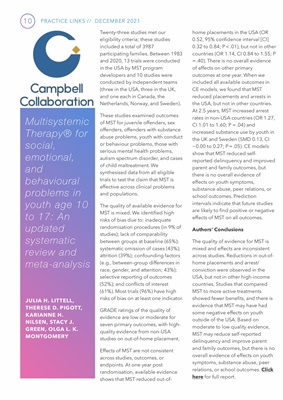
10 PRACTICE LINKS // DECEMBER 2021
JULIA H. LITTELL,
THERESE D. PIGOTT,
KARIANNE H.
NILSEN, STACY J.
GREEN, OLGA L. K.
MONTGOMERY
Multisystemic
Therapy® for
social,
emotional,
and
behavioural
problems in
youth age 10
to 17: An
updated
systematic
review and
meta-analysis Twenty-three studies met our
eligibility criteria; these studies
included a total of 3987
participating families. Between 1983
and 2020, 13 trials were conducted
in the USA by MST program
developers and 10 studies were
conducted by independent teams
(three in the USA, three in the UK,
and one each in Canada, the
Netherlands, Norway, and Sweden).
These studies examined outcomes
of MST for juvenile offenders, sex
offenders, offenders with substance
abuse problems, youth with conduct
or behaviour problems, those with
serious mental health problems,
autism spectrum disorder, and cases
of child maltreatment. We
synthesised data from all eligible
trials to test the claim that MST is
effective across clinical problems
and populations.
The quality of available evidence for
MST is mixed. We identified high
risks of bias due to: inadequate
randomisation procedures (in 9% of
studies); lack of comparability
between groups at baseline (65%);
systematic omission of cases (43%);
attrition (39%); confounding factors
(e.g., between-group differences in
race, gender, and attention; 43%);
selective reporting of outcomes
(52%); and conflicts of interest
(61%). Most trials (96%) have high
risks of bias on at least one indicator.
GRADE ratings of the quality of
evidence are low or moderate for
seven primary outcomes, with highquality evidence from
non-USA
studies on out-of-home placement.
Effects of MST are not consistent
across studies, outcomes, or
endpoints. At one year post
randomisation, available evidence
shows that MST reduced out-ofhome placements in the USA
(OR
0.52, 95% confidence interval [CI]
0.32 to 0.84; P < .01), but not in other
countries (OR 1.14, CI 0.84 to 1.55; P
= .40). There is no overall evidence
of effects on other primary
outcomes at one year. When we
included all available outcomes in
CE models, we found that MST
reduced placements and arrests in
the USA, but not in other countries.
At 2.5 years, MST increased arrest
rates in non-USA countries (OR 1.27,
CI 1.01 to 1.60; P = .04) and
increased substance use by youth in
the UK and Sweden (SMD 0.13, CI
−0.00 to 0.27; P = .05). CE models
show that MST reduced selfreported
delinquency and improved
parent and family outcomes, but
there is no overall evidence of
effects on youth symptoms,
substance abuse, peer relations, or
school outcomes. Prediction
intervals indicate that future studies
are likely to find positive or negative
effects of MST on all outcomes.
Authors' Conclusions
The quality of evidence for MST is
mixed and effects are inconsistent
across studies. Reductions in out-ofhome placements and arrest/
conviction were observed in the
USA, but not in other high-income
countries. Studies that compared
MST to more active treatments
showed fewer benefits, and there is
evidence that MST may have had
some negative effects on youth
outside of the USA. Based on
moderate to low quality evidence,
MST may reduce self-reported
delinquency and improve parent
and family outcomes, but there is no
overall evidence of effects on youth
symptoms, substance abuse, peer
relations, or school outcomes. Click
here for full report.